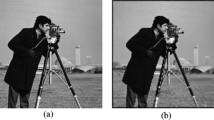Abstract
This paper proposes a fusion-based edge-sensitive interpolation method (FEID) for intra-field deinterlacing. The proposed FEID is composed of three steps: (1) region classification by a gradient-based region selection approach, (2) pre-interpolation by a 6-tap fixed coefficient Wiener filter, (3) data fusion by the linear minimum mean square-error estimation (LMMSE) technique. Specifically, three directional neighboring pixel sets are defined in three directions (45°, 90°, and 135°) for every missing pixel. And each set produces an estimate of the pixel to be interpolated with a Wiener filter. With the information that gathered from the three directional neighboring pixel sets, a more robust estimate is obtained by fusing these directional estimates with the LMMSE technique. For fast implementation, we propose a gradient-based region selection approach that classifies a local region into two different classes, Region 1 and Region 2. The LMMSE-based data fusion method is used in Region 1; a fast deinterlacing algorithm is used in Region 2 to reduce the computational complexity. Compared with existing deinterlacing methods, the proposed method FEID improves the visual quality of the interpolated edges while maintaining a higher peak signal-to-noise–ratio (PSNR) level.








Similar content being viewed by others
References
24 Kodak images. Available: http://r0k.us/graphics/kodak. Accessed 20 May 2013
Bellars EB, De Haan G (2000) De-interlacing: a key technology for scan rate conversion. Elsevier, Amsterdam
Chen X, Jeon G, Jeong J (2012) Filter switching interpolation method for deinterlacing. Opt Eng 51(10):107402
Chen PY, Lai YH (2007) A low-complexity interpolation method for deinterlacing. IEICE Trans Inf Syst 90(2):606–608
Chen T, Wu HR, Yu ZH (2000) Efficient deinterlacing algorithm using edge-based line average interpolation. Opt Eng 39(8):2101–2105
Choi H, Lee C (2011) Motion adaptive deinterlacing with modular neural networks. IEEE Trans Circ Syst Video Technol 21(6):844–849
De Haan G (1998) Deinterlacing—an overview. In:Proc of the IEEE 86(9): 1839–1857
De Haan G (2007) Television display processing: past & future. In: Proceedings of the 2007 I.E. international conference on consumer electronics (ICCE’07) 1–2
El-Khamy SE, Hadhoud MM, Dessouky MI et al. (2004) Optimization of image interpolation as an inverse problem using the LMMSE algorithm. In: Proceedings of the 12th IEEE Mediterranean 1: 247–250
El-Khamy SE, Hadhoud MM, Dessouky MI et al (2005) Efficient implementation of image interpolation as an inverse problem. Digit Signal Process 15(2):137–152
Fan YC, Lin HS, Chiang A, Tsao HW, Kuo CC (2008) Motion compensated deinterlacing with efficient artifact detection for digital television displays. J Disp Technol 4(2):218–228
Karmen EW, Su JK (1999) Introduction to optimal estimation. Springer-Verlag
Kim W, Jin S, Jeong J (2007) Novel intra deinterlacing algorithm using content adaptive interpolation. IEEE Trans Consum Electron 53(3):1036–1043
Michaud F, Le Dinh CT, Lachiver G (1997) Fuzzy detection of edge-direction for video line doubling. IEEE Trans Circ Syst Video Technol 7(3):539–542
Park SJ, Hong SM, Jeong J (2011) Deinterlacing algorithm using direction-oriented inverse-free wiener filtering. Opt Eng 50(6):067014
Park SJ, Jeon G, Jeong J (2010) Computation-aware algorithm selection approach for interlaced-to-progressive conversion. Opt Eng 49(5):057005
Park SJ, Jeong J (2011) Local surface model–based deinterlacing algorithm. Opt Eng 50(1):017004
Park MK, Kang MG, Nam K, Oh SG (2003) New edge dependent deinterlacing algorithm based on horizontal edge pattern. IEEE Trans Consum Electron 49(4):1508–1512
Poor HV (1994) An introduction to signal detection and estimation. Springer-Verlag
Trocan M, Mikovicova B, Zhanguzin D (2012) An adaptive motion-compensated approach for video deinterlacing. Multimed Tools Appl 61(3):819–837
Wang Z, Bovik AC, Sheikh HR et al (2004) Image quality assessment: from error visibility to structural similarity. IEEE Trans Image Process 13(4):600–612
Wang J, Jeon G, Jeong J (2012) Efficient adaptive deinterlacing algorithm with awareness of closeness and similarity. Opt Eng 51(1):017003
Wang J, Jeon G, Jeong J (2013) Deinterlacing using Taylor series expansion and polynomial regression. IEEE Trans Circ Syst Video Technol 23(5):912–917
Wang D, Vincent A, Blanchfield P (2005) Hybrid de-interlacing algorithm based on motion vector. IEEE Trans Circ Syst Video Technol 15(8):1019–1025
Yoo H, Jeong J (2002) Direction-oriented interpolation and its application to de-interlacing. IEEE Trans Consum Electron 48(4):954–962
Zhang L, Wu X (2006) An edge-guided image interpolation algorithm via directional filtering and data fusion. IEEE Trans Image Process 15(8):2226–2238
Zhu Y, Schwartz SC, Orchard MT (2001) Wavelet domain image interpolation via statistical estimation. In: Proceedings of the 2001 I.E. international conference on image processing 3: 840–843
Acknowledgments
The authors would like to thank the reviewers for their insightful and constructive comments that help improve this paper. This work was supported by the National Science Foundation of China (61234001).
Author information
Authors and Affiliations
Corresponding author
Rights and permissions
About this article
Cite this article
Zhang, H., Wang, R., Liu, W. et al. Fusion-based edge-sensitive interpolation method for deinterlacing. Multimed Tools Appl 74, 7643–7659 (2015). https://doi.org/10.1007/s11042-014-1997-z
Published:
Issue Date:
DOI: https://doi.org/10.1007/s11042-014-1997-z




